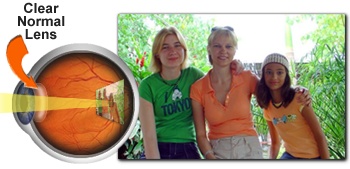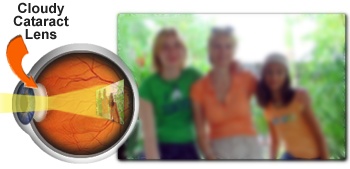| |
|
What is a Cataract?
Loss of eye sight from cataracts is usually
preventable!
With the formation of a cataract, activities like
reading, bowling, or driving can be difficult. Fortunately,
vision can be restored quickly, allowing the patient to return
home within a few hours. With new advances in cataract surgery,
vision improvement begins almost immediately, and an eye patch
isn't even needed. |
 |
 |
| |
A Cataract is the clouding of the lens of the
eye. Normally, light passes through the
clear lens and is focused onto the Retina. However, the natural
aging process can cause the lens to become cloudy. The Cataract
or cloudy lens blocks the passage of light through the eye and
causes distorted or blurred vision, glare, or difficulty seeing
in poor lighting conditions.
Cataract surgery is the most
common operation in the world. In the United States, millions
procedures are performed annually. There are many millions of
cases of early cataracts among Americans aged 40 and older, and
50 percent of people older than 65 have developed significant
cataracts.
Is Cataract Surgery right for me?
Boynton Eye Institute's
Cataract and IOL Consultation
Your refractive
consultation is an information session where we will
discuss your vision issues and goals, your refractive
options and what you can expect from surgery. We will
review your contact lens and/or eyeglass history and run
tests as needed to determine the uniformity of your
cornea and recommend the best procedure for you. Your
consultation may be covered by insurance. If not, then there is
a $160 charge for this appointment.
This 2-2½ hour
dilated consultation typically includes a complete review of
overall eye and systemic health plus an assessment of other eye
conditions and an evaluation of the retina.
Learn what you need to know about your consultation
The Cataract Procedure
Cataract surgery is performed on an out-patient basis. You
will not need to be hospitalized or put to sleep for your doctor
to perform your surgery. The procedure normally takes less than
30 minutes and you can return home shortly after your procedure.
Most people will enjoy improved vision by the day after surgery
or within a few days following the procedure.
Your doctor
will first administer a light sedative which will relax your
nerves and keep you comfortable during the procedure. Anesthetic
eye drops will be used to completely numb the eye. Your doctor
will use the latest technology for cataract removal. The entire
procedure is typically performed through an incision that is
smaller than 1/8 of an inch and does not require stitches to
heal.
Once the cataract is removed, an intra-ocular lens
(IOL) is placed where the cataract lens was removed, to restore
your sight. Most patients will not require an eye patch and will
not have significant discomfort. Most patients can return
to their normal daily routines, including reading, driving, and
exercise soon after surgery.
What should I expect
about my Cataract
surgery?
Before deciding to have Cataract surgery, you
will need an initial examination to make sure your eyes are
suitable for surgery. Your doctor will take a complete history
about your medical and eye health and perform a thorough
examination of both eyes. The best lens implant available to
accommodate each patient's individual situation. We will be
certain that you receive professional and thorough education
regarding lens implant options.
Learn more » |
| |
|
|
|
| |
Cataract Surgery Financing
Cataract surgery and
standard (monofocal) intraocular lenses (IOLs) are covered by Medicare
and most health insurance plans, as this procedure is considered
medically necessary. Upgrading cataract surgery to Lifestyle IOLs to
correct presbyopia or astigmatism, however, is only partially covered by
Medicare or other insurance for the cataract portion of fees, as these
IOLs are considered to be a luxury and not a medical necessity.
The cost of surgery changes over time just as most products and services
change periodically, but our current per-eye prices for these procedures
are as follows:
When diagnosed as needed due to its progressive
stage, the surgery for cataracts and the placement of a
Monofocal IOL is usually covered on approval by insurance (less
deductibles and co-pays). If you choose to upgrade from a Monofocal IOL
to a Multifocal, Accommodating, or Toric IOL, you will pay out-of-pocket
for the cost of the Lifestyle lens and the additional testing and
follow-up care needed. |
| |
|